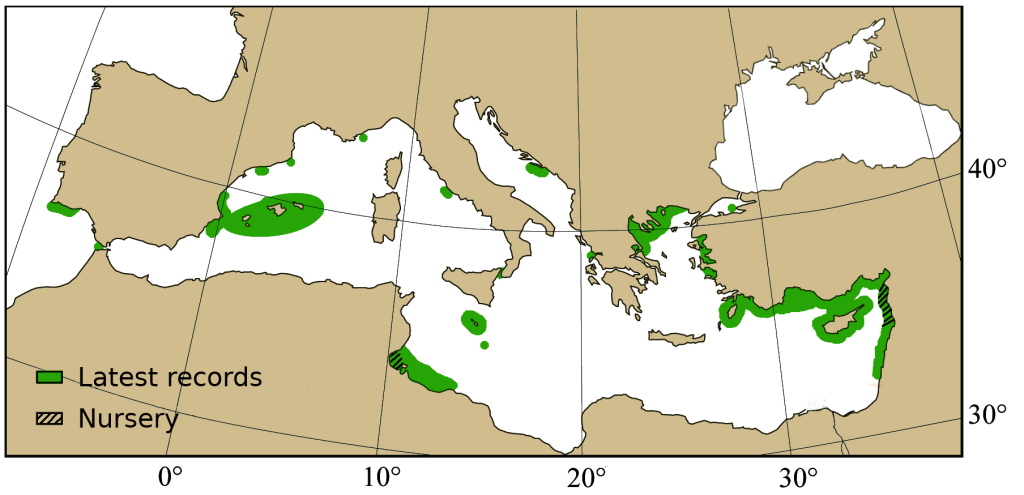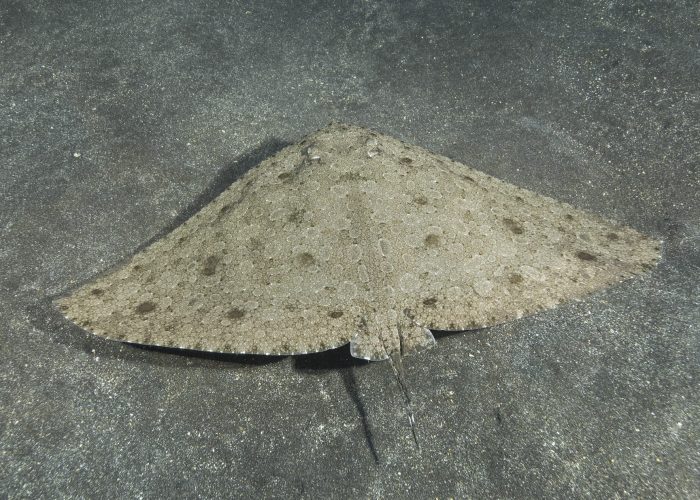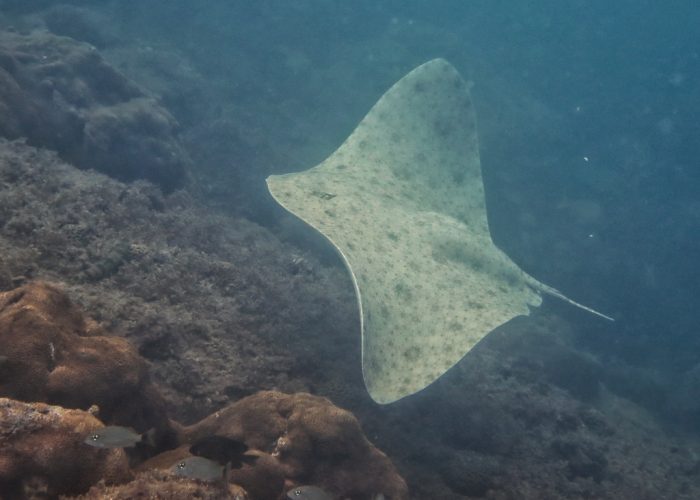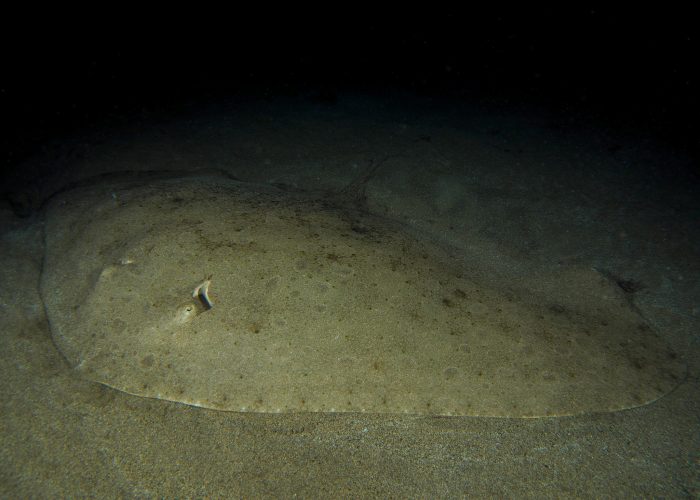Gymnura altavela
Common name : Spiny Butterfly Ray
Order: Myliobatiformes
Family: Gymnuridae
Synonyms: Pteroplatea altavela
Misidentifications: None
Short description
Very large species. Very broad lozenge-shaped pectoral fin disk about twice as wide as long. Obtuse muzzle. One to two small venomous barbed needles inserted at the base of a short tail (one third of the length of the disk) larger in females than in males. A skin crest is present on the dorsal and ventral sides of the tail. Dorsal surface with spines in adults while smooth skin in juveniles. Small tentacle at the inner lateral edge of the spiracle. Small and thin pelvic fins.
Color: Juxtaposition of small dark or light spots, forming a mosaic of light on a dark brown to grayish brown or reddish brown background dorsal surface. Light white, slightly pinkish or rusty ventral surface. White or brownish pelvic fins. Three to five black bands on the tail.
Measurements:
- Disk width (DW): 50-200 cm (max 400 cm)
- Total length (TL): 100-200 cm (max 285 cm)
- Weight: up to 290 kg
Swimming pattern: Oscillatory locomotion
Biology / Ecology
Feeds on small fishes, crustaceans, mollusks and plankton.
Behaviour: Solitary.
Reproduction: Viviparous (aplacental viviparity with histotrophy). Size at maturity (DW): 78-130 cm males, 102-108 cm female. Gestation period: 4-9 months. Juveniles per litter: 1-8. Size at birth: 38-44 cm.
Habitat: Benthic in subtropical and temperate waters on sandy bottoms, sometimes on Posidonia meadows. Occurs also in estuaries and lagoons. Depth: 0 – 500 m (more typically in water less than 50 m deep). Distribution probably habitat-dependent.
The genus Gymnura is derived from the Greek word gymnos meaning naked.
Distinguishing characteristics
- Large disk, extreme development of its pectoral fins.
- Tail very short with serrated spines.
- Small dark or light spots or blotches.
Myliobatiformes: No caudal and anal fin. Thin tail like a whip.
Gymnuridae: Depressed body, rhombic disc, disc about twice as broad as long.
Distribution
Worldwide: Eastern Atlantic. Black Sea.
Mediterranean: Unequally distributed in the Mediterranean. The Gulf of Gabès (Tunisia) is identified as a nursery and sensitive area. High abundance in the Gulf of Antalya (Turkey). Some records in the Aegean Sea and along the Syrian coast. Few records in the western Mediterranean.
- Occurrence: Rare.
- Latest records: Cyprus (2018-2022), Black Sea (2019), Tunisia (2017), Turkey (2014), Syria (2013), Edremit, Izmir and Sığacık Bay – Turkey (2009), Southern Adriatic (2000), Malta (1997).

Any recent observation not on the map?
Contact us!
Conservation
Threats: Industrial and artisanal fisheries using demersal trawl, shrimp trawl, bottom set gillnets, and beach seine nets. Retained for human consumption, sometimes winged and traded internationally.
Protection level:
- Global: Critically Endangered (IUCN 2021, last assessment: 2020)
- Mediterranean: Data Deficient (IUCN 2016, last assessment: 2016)
- Europe: Data Deficient (IUCN 2015, last assessment: 2014)
Key references
- Alkusairy H., Ali M., Saad A., Reynaud C., Capapé C. 2014. Maturity, Reproductive Cycle and Fecundity of Spiny Butterfly Ray, Gymnura altavela (Elasmobranchii: Rajiformes: Gymuridae), from the Coast of Syria (Eastern Mediterranean). Acta Ichthyologica Et Piscatoria 44: 229–240.
- Carpentieri P., Nastasi A., Sessa M., Srour A. 2021. Incidental catch of vulnerable species in Mediterranean and Black Sea fisheries – A review. General Fisheries Commission for the Mediterranean. Studies and Reviews 101: I-317.
- Dulcic J., Jardas I., Onofri V, Bolotin J. 2003. The roughtail stingray Dasyatis centroura (Pisces: Dasyatidae) and spiny butterfly ray Gymnura altavela (Pisces: Gymnuridae) from the southern Adriatic. Journal of the Marine Biology Association U.K. 83: 871-872.
- Eronat E.G.T., Özaydın O. 2014. Length–weight relationship of cartilaginous fish species from central Aegean Sea (Izmir Bay and Sığacık Bay). Ege Journal of Fisheries and Aquatic Sciences 31(3): 119–125.
- Giovos I., Spyridopoulou R. A., Doumpas N., Glaus K., Kleitou P., Kazlari Z., Katsada D., Loukovitis D., Mantzouni I., Papapetrou M., Papastamatiou Y.P., Moutopoulos D. K. 2021. Approaching the “real” state of elasmobranch fisheries and trade: A case study from the Mediterranean. Ocean & Coastal Management 211: 105743.
- Giovos I., Serena F., Katsada D., Anastasiadis A., Barash A., Charilaou C., Hall-Spencer J.M.,Crocetta F.,Kaminas A., Kletou D, Maximiadi M., Minasidis V., Moutopoulos D.K., Aga-Spyridopoulou R.N., Thasitis I., Kleitou P. 2021. Integrating literature, biodiversity databases, and citizen-science to reconstruct the checklist of Chondrichthyans in Cyprus (Eastern Mediterranean Sea). Fishes 6(3): 24.
- O’Keefe M., Bengil EG., Palmer JL, Beton D, Çağlar Ç., Godley B.J, Özkan M., Snape R.T.E., Broderick A.C. 2023. Diversity and distribution of elasmobranchs in the coastal waters of Cyprus: using bycatch data to inform management and conservation. Front. Mar. Sci. 10: 1181437.
- Psomadakis P.N., Dalù M, Scacco U., Vacchi M. 2005. A rare batoid fish Gymnura altavela (Chondrichthyes: Gymnuridae) captured in the Tyrrhenian Sea. JMBA2 – Biodiversity Records (published online).
- Schembri T., Fergusson I.K., Schembri P.J. 2003. Revision of the records of sharks and rays species from the Maltese Islands (Chordata: Chondrichthyes). The Central Mediterranean Naturalist de Oceanología Academia de Ciencias de Cuba and Centro de Investigaciones de Quintana Roo, Mexico 4(1): 71–104.
- Türker D., Zengin K., Tünay Ö.K. 2019. Length-weight relationships for nine chondrichthyes fish species from Edremit Bay (north Aegean Sea). Turkish Journal of Fisheries and Aquatic Sciences 19(1): 71–79.



